There is a Whole Family of European Farmhouse Yeasts
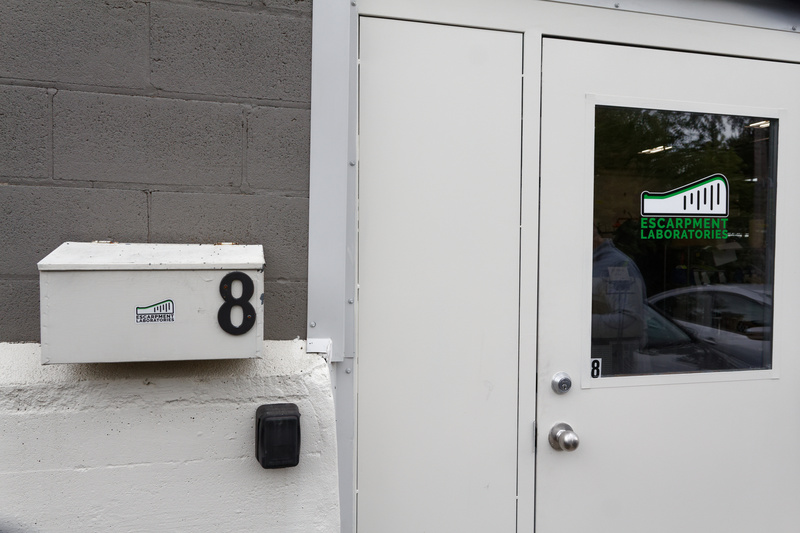
Entrance to Escarpment Labs, where a lot of this research was done. Guelph, Canada. |
Six years ago, the paper that told us where kveik came from was published. In my mind, the immediate question to ask after that was: what about the farmhouse yeast that was not from Western Norway? Where did that fit? Luckily for me, and you, the same question occurred to Richard Preiss and Kristoffer Krogerus, two of the researchers behind that kveik paper, and the same year they started working to find out. Yes, in 2018.
That work got hit by covid and other problems, and so ended up dragging out, but now they (with others) have finally published a preprint on exactly this. A preprint, if you're not familiar, is an unreviewed scientific paper. Basically it's what gets submitted to the journal the researchers hope will eventually publish it. So this paper is not reviewed yet, but I'm pretty confident it will stand up to scrutiny.
So what does the paper say? Well, let's start by doing a quick review of the yeasts they looked at.
The yeasts
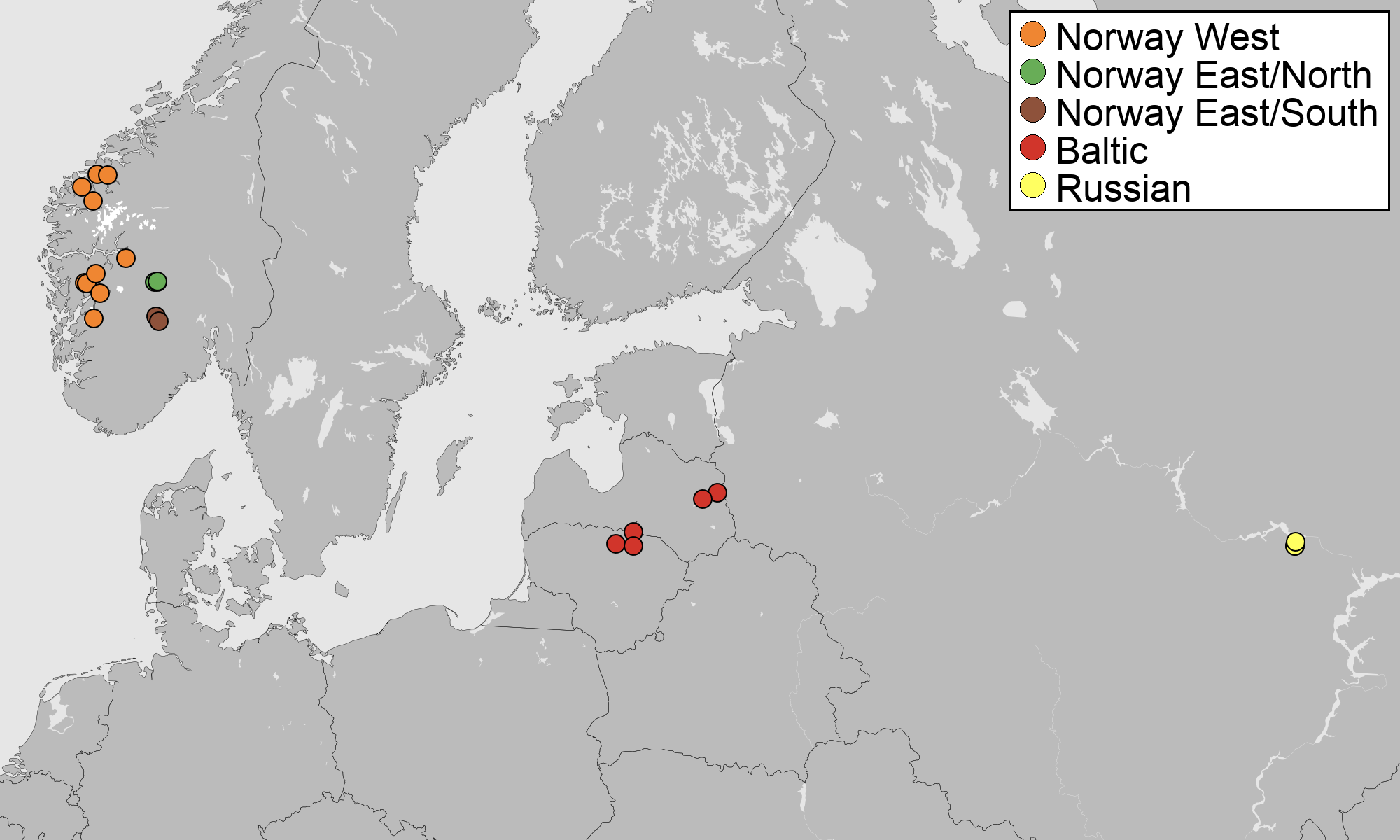
Map of the yeasts included in the study. |
The map above has a dot for every yeast that was included in the study, showing where they came from. I'll walk you through the different groups quickly:
- Norway West
- This is the kveiks, which are already quite well known.
- Norway East/North
- This is the gong from Ål in Hallingdal, Eastern Norway. I wrote about visiting Sverre Skrindo and brewing with him, but it turned out other people in the village also had gong, so I was able to collect a few more.
- Norway East/South
- This is the berm from Atrå in Telemark, also Eastern Norway. So far only two cultures of berm are known (#54 and #57), although I have two leads that in theory could help us find more. Maybe.
- Baltic
- In north Lithuania there are farmhouse brewers, some of them commercial, who have their own yeasts. I've collected some of these, and Simonas Gutautas of Dundulis collected a few more. Thanks to Reinis Pļaviņš at Labietis in Riga we've managed to get two from Latvia as well. Both are from the eastern part of Latvia known as Latgale. All of the Baltic yeast actually studied in the paper was collected by Simonas and Reinis.
- Russia
- Finally, we have three cultures from Chuvashia in Russia, on the middle Volga. All of them come from Chuvashians, a people speaking a Turkic language, and sometimes I wonder if we should have labeled these Chuvashian instead. On my first visit there in 2017 I was able to collect two cultures. I managed to get another trip in 2020, right before covid struck, and got hold of a third culture. I'm sure there's lots more to be found, but that's not going to be easy now, unfortunately.
The paper also includes two strains of African farmhouse yeast from Ghana, but I don't know much about them. Africa seems to have an absolutely mind-blowing variety of farmhouse yeast, but I've found that dealing with Europe is almost more than I can handle, so for the sake of my own sanity I've stayed out of Africa.
The family tree
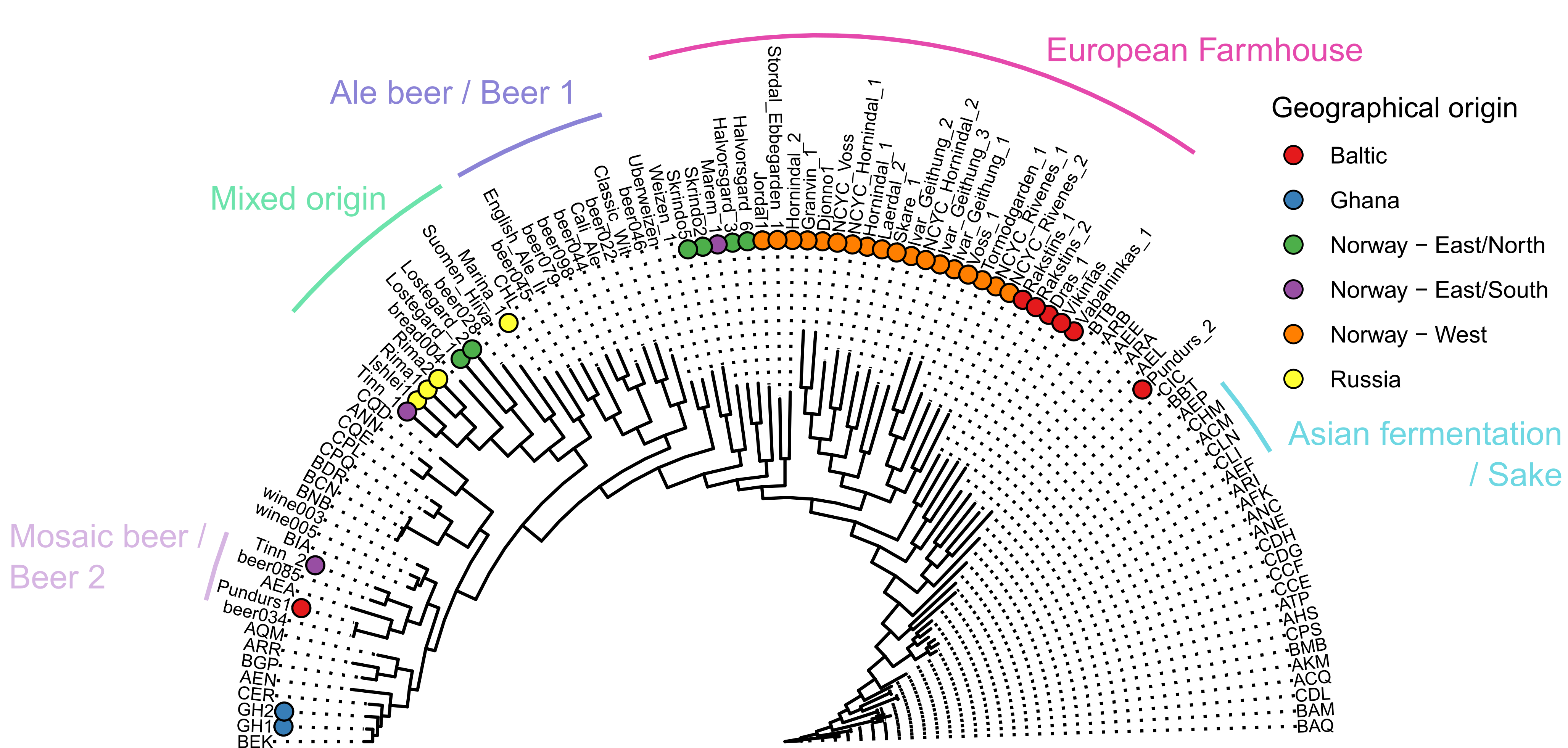
The family tree (you may want to click the image for a bigger version) |
The big finding is that group you see in the upper middle: a large group of farmhouse yeasts all next to each other. Yeasts from the kveik, gong, and berm areas as well as the Baltic all group right next to each other, with nothing else in between. The conclusion is that European farmhouse yeast is a separate family of yeast. Farmhouse yeast really is a separate type of yeast. And that family spans Norway, Latvia, and Lithuania, at least.
I've been using the term "farmhouse yeast" for many years now, and now we learn that it's not just a functional category (like bread yeast, or wine yeast), but it's also a genetic family, a type of yeast.
We've gone from having three kinds of beer yeast: Beer 1 and Beer 2 (and a few in Mixed) to having four kinds: Beer 1, Beer 2, (Mixed), and European farmhouse yeast. That's astonishing, and something that forces us to really re-evaluate what we thought we knew about the history of beer and yeast.
We learn more than just that, though, because like the big Beer 1 family, the European farmhouse yeast family has a clear geographic substructure. It divides into:
- Kveik
- Kveik remains a separate group, even as part of the bigger farmhouse yeast family.
- Gong and berm
- If you look carefully you can see that four gong strains cluster next to each other, with one berm in the middle. In other words: gong and berm is a single type of yeast, not two. But they're also part of the farmhouse family.
- Baltic
- Next to the Norwegian yeasts there is a group of five Baltic strains as well. So Baltic farmhouse yeast is clearly a yeast group of its own. In fact, the two Latvians sit next to each other, and the three Lithuanians are also next to each other. So perhaps there are even separate families of Latvian and Lithuanian farmhouse yeast. Unfortunately, there aren't enough strains included in the study for us to be sure about that.
In short, Norway is home to two living families of farmhouse yeast: one called kveik, in Western Norway, and one that I guess needs to be named either gong or berm, in Eastern Norway. It might sound odd that there should be such a clear-cut division in Norway, but the southern half of Norway in a way is two different countries culturally. The reason is a giant mountain barrier running all the way from Trondheim in central Norway down to the southern tip of the country.
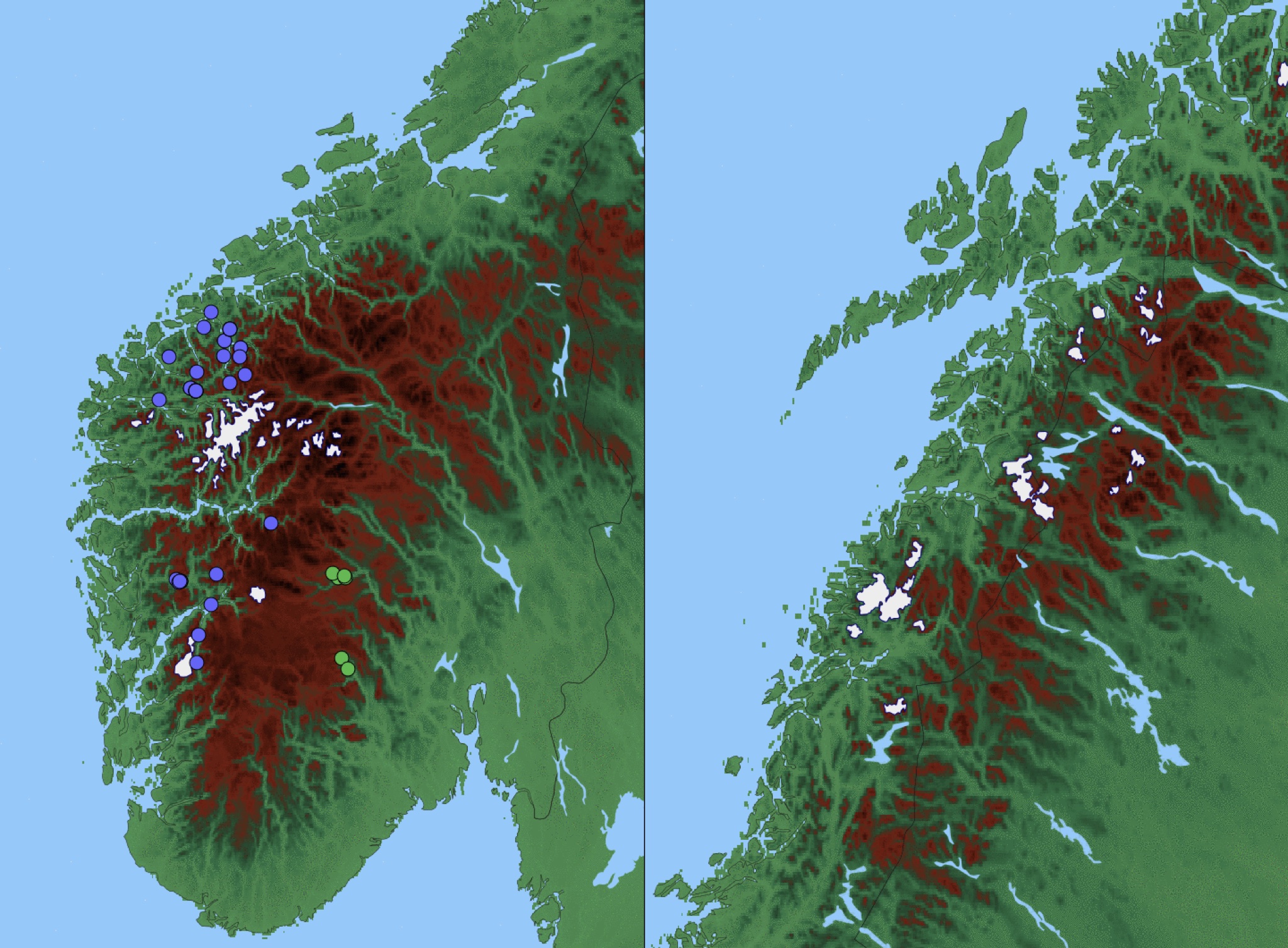
This map, colour-coded by height, shows the east-west divide very clearly. I chose the colours so that anything shaded brown is typically too high to be inhabited. |
In fact, my recent Norwegian book (blog post) was partly about how Norwegian beer culture has a very distinct east/west divide. Now we learn that this divide is clearly visible also in the genetics of Norwegian farmhouse yeast.
It's all quite a lot to take in, and the full implications of these findings will take time to digest, I think.
Beer 1 or not Beer 1?
One thing you may note is that the original 2018 paper concluded kveik belonged to the Beer 1 group. In this tree the whole European farmhouse group appears outside the Beer 1 family. That's most likely because for this study they were able to sequence the genes of many more farmhouse yeasts, so the algorithm had more to work with. Another preprint, by Norwegian researchers, also placed kveik outside the Beer 1 group, so very likely the correct conclusion is that European farmhouse yeast is not part of the Beer 1 group.
There are, however, strong similarities between the farmhouse yeasts and the Beer 1 yeasts, so the original conclusion was not just a simple mistake. Take a look at the diagram below.
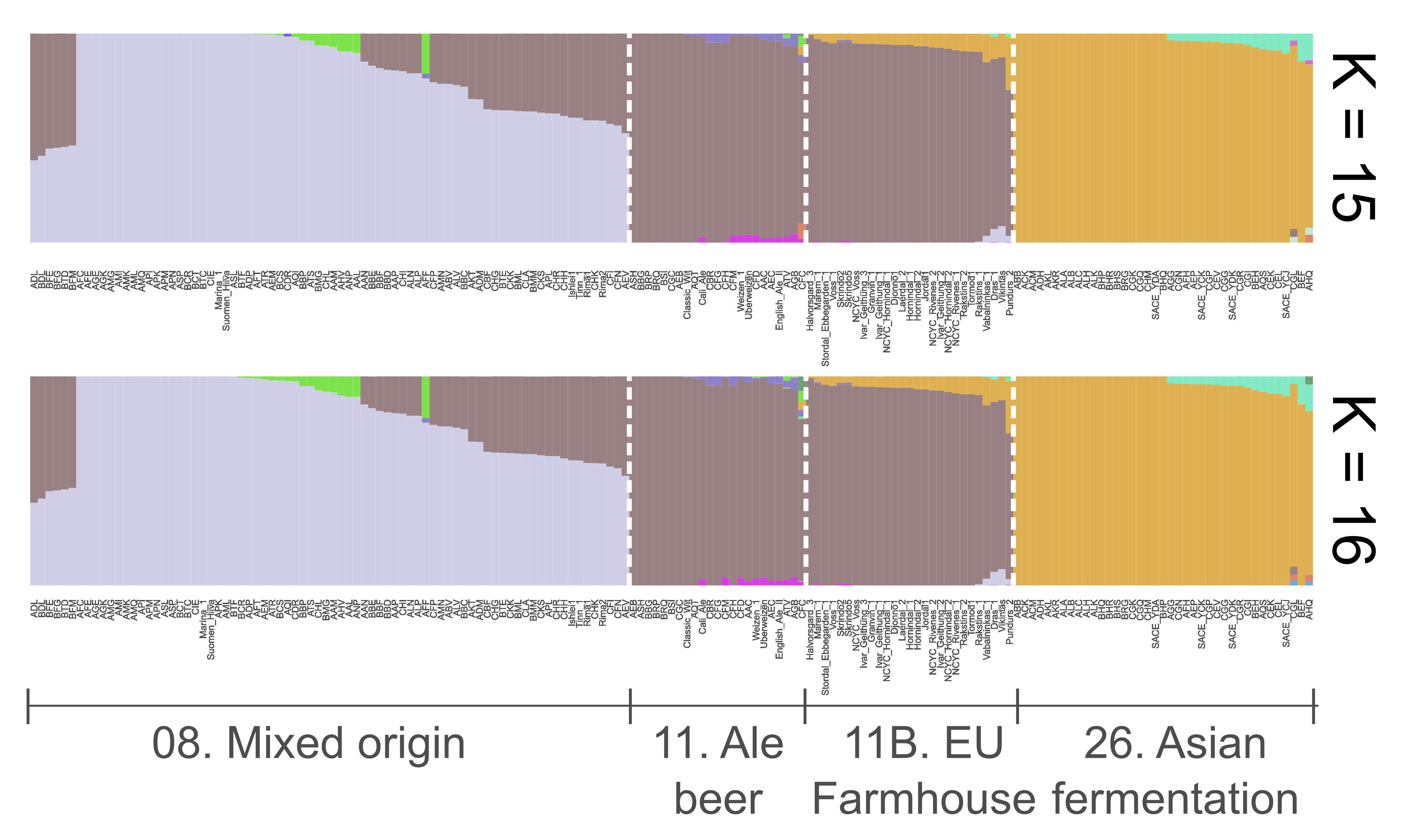
Result of clustering the SNPs in each genetic subpopulation. "Ale beer" is really "Beer 1". |
Exactly how this diagram got produced is pretty technical, but essentially what they did was to take the mutations (SNPs) present in the various yeasts and cluster them using an algorithm. In the diagram above they've told the algorithm they want 15 and 16 clusters (that's the "K=" part), and the algorithm dutifully sorts all the mutations into that many groups. Each cluster/group gets a separate colour, and the genome of each strain is displayed as a thin vertical column. You see the yeast families along the bottom.
You see how a large part of the farmhouse mutations has a brownish colour; the same colour dominates Beer 1 (shown as "Ale beer" here). Clearly the two groups do have a lot in common.
A more surprising finding is the top part of the farmhouse genomes. See the orange colour there, and how it's shared with a group called "Asian fermentation"? Apparently part of the European farmhouse genome is shared with that group. The Asian fermentation group comes from the 1,011 yeasts paper, and intriguingly it does not include Japanese sake, which is a separate (but related) group. Instead, it comes from Taiwan, Vietnam, Laos, China, Indonesia, Malaysia, and Thailand, and the yeasts have been used in rice beer, distillation, and to some extent were also found in nature.
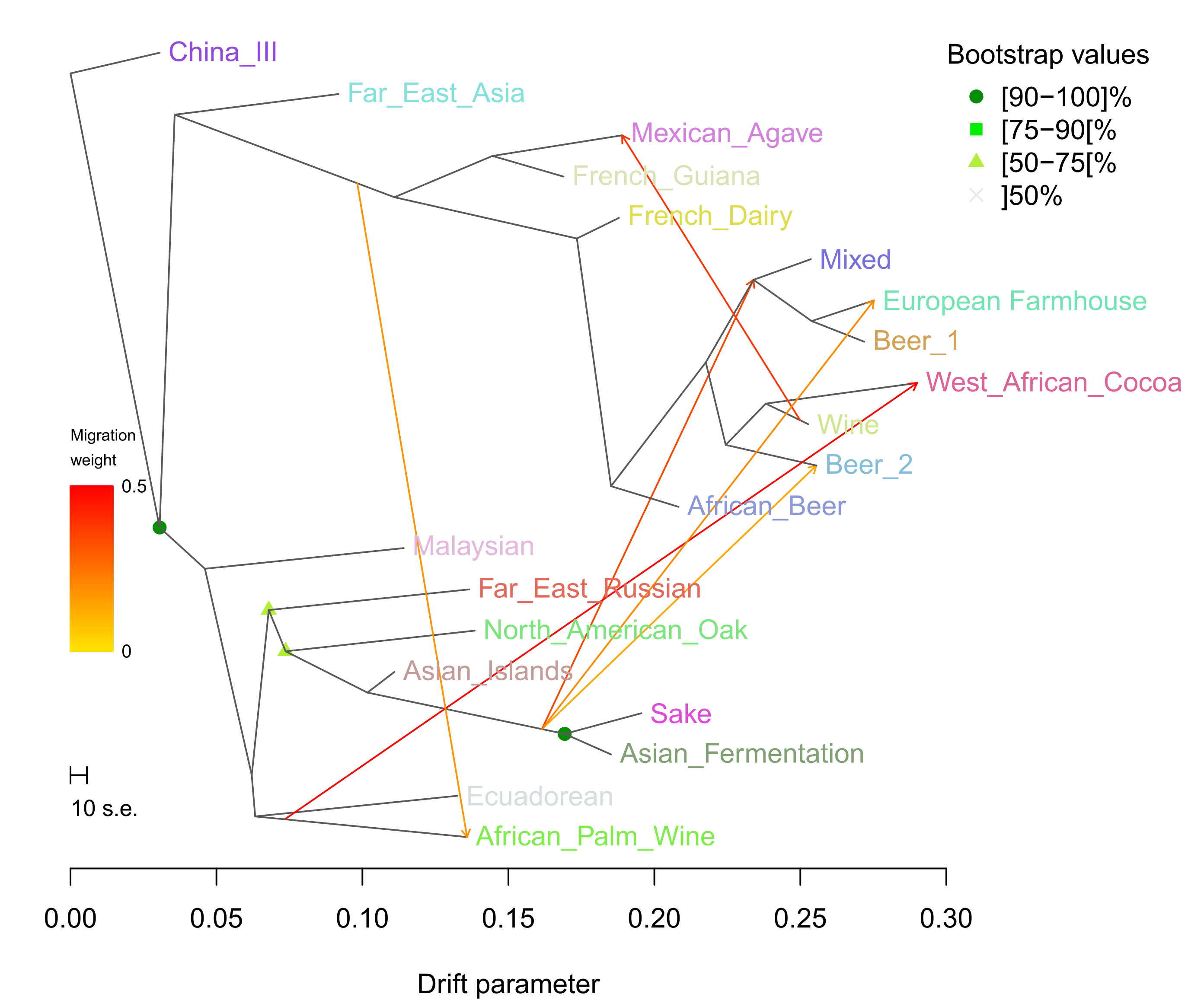
Phylogenetic network diagram, showing shared genes across the tree |
As you can see in this diagram, a different analysis method finds the same thing, making it clear that the connection is very real. In this diagram the algorithm says the commonality is with the shared ancestor of Japanese sake yeast and Asian fermentation, which seems to imply it goes back a long time. But why does European farmhouse yeast share a substantial amount of its genome with Asian yeasts? Good question!
The historical and evolutionary implications of all this is such a big subject that I think I had better return to that in another post.
The oddballs
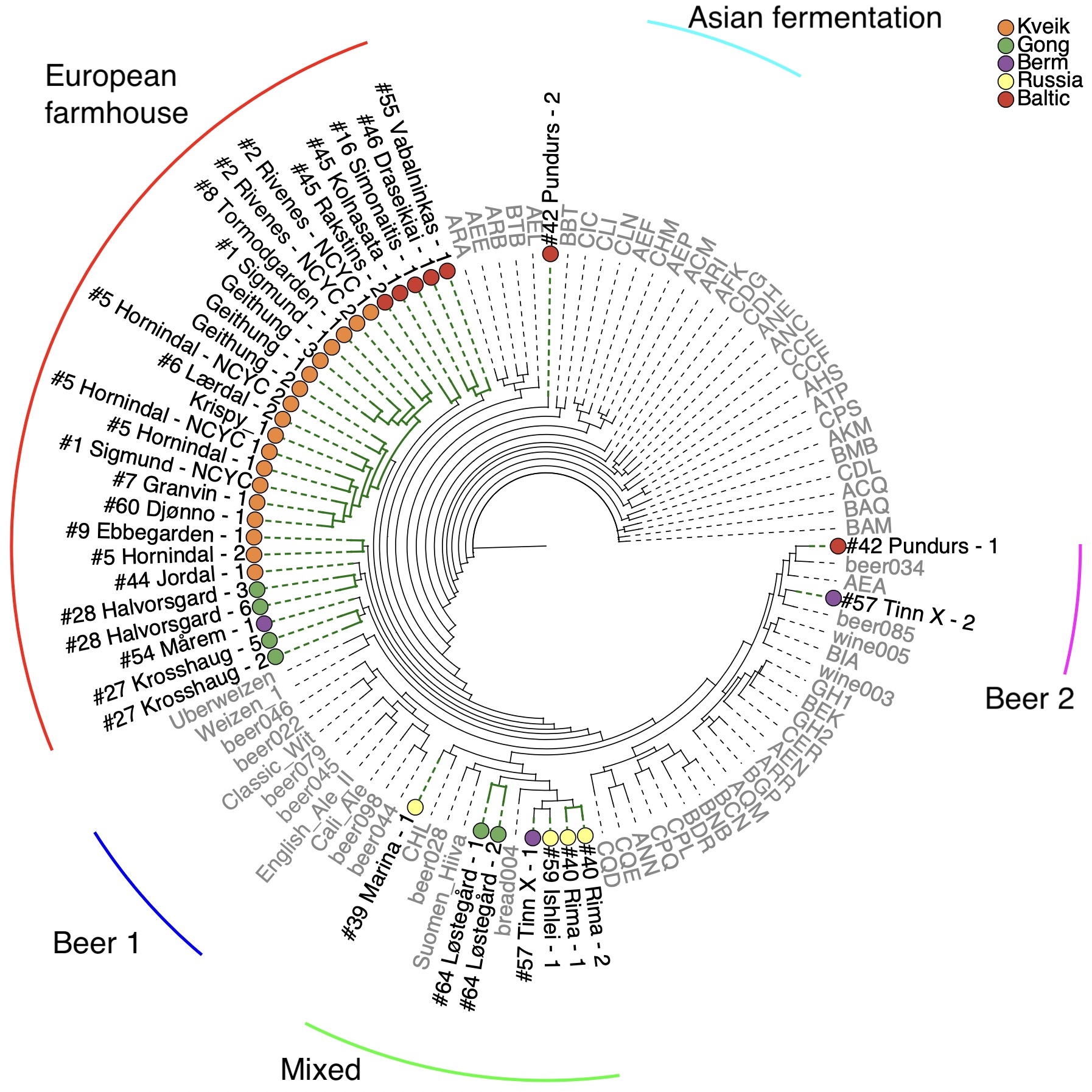
Yeast tree again. This time rendered by me, but from the same underlying data. |
If you go back to the original family tree you'll note that there are also some oddballs that don't cluster together with the other farmhouse yeasts. Let's walk through them quickly:
- #42 Pundurs - 2: At the top. This one is from Latvia, and is an outlier that doesn't cluster together with anything else. Kristoffer Krogerus pointed out that on the cluster plots (above) it has a large proportion of European farmhouse/Beer 1 genes, but also an unusually large proportion of the Asian fermentation genes. So Kristoffer thinks it's a true farmhouse yeast, even if it doesn't appear with the others in the tree.
- #42 Pundurs - 1: Sits in the Beer 2 group, very close to a strain coded 'beer034'. Unfortunately, we don't know what that is, but it's possible that #42 Pundurs is a mix of real farmhouse yeast and a commercial yeast that somehow crept in, for example from bread baking.
- #57 Tinn X: This yeast culture is a berm, but this one strain clusters in Beer 2 fairly close to 'beer085', which Kristoffer Krogerus tentatively identified as WLP570 - Belgian Golden Ale. The other clusters in the Mixed group together with three Russian strains. So Tinn X really could be a mix of contaminations, both bread yeast and Belgian yeast from a home brewer. As you'll note in the story about it, I got the yeast from a guy who had used it in home brewing, so the original culture might still have been pure. All of this is guesswork, however. (We can figure this out later, however, because I got hold of the original culture from his aunt.)
- All the four Russian strains cluster under Mixed, which is not great news. One of them is even quite close to Suomen Hiiva, the Finnish bread yeast. So it's very possible that all of what was picked for the study is commercial baking yeast, unfortunately. That does not mean that all the Chuvashian yeast is necessarily contaminants or modern baking yeast, but we need more studies to say.
- Two strains were studied from #64 Løstegård, a gong, and both are quite close to each other, and both in the Mixed group. So this might also really be baking yeast, unfortunately.
In short, what they found was a lot of undoubted farmhouse yeast, one genuine oddball that we don't know what is, and a bunch of strains that seem like they really could be just contaminants from home brewing, baking, or even that the culture at one time was replaced with commercial yeast.
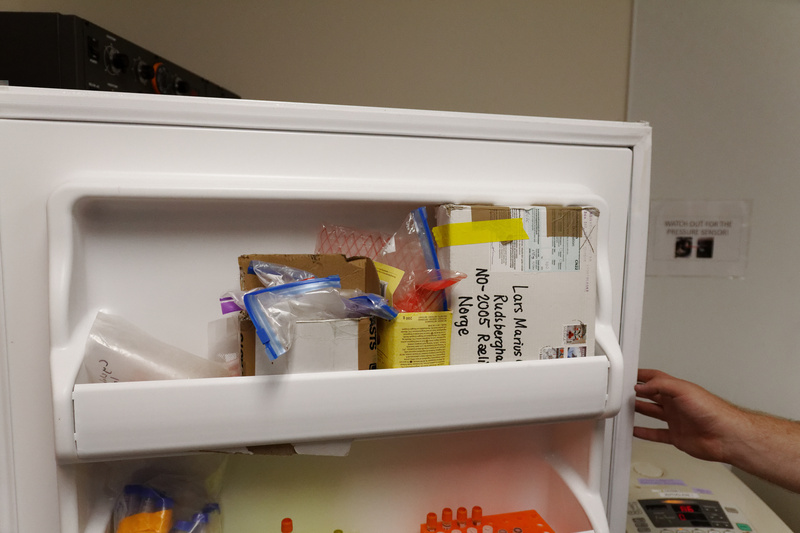
Richard Preiss holding open a yeast fridge at Escarpment Labs |
Conclusion
That is quite a lot to take in all at once, but the big headline is that there is actually such a thing as European Farmhouse Yeast, spanning Norway, Latvia, and Lithuania, at least.
I'll do a separate post on the historical implications of this, and probably also another post on additional findings in the paper, because there is a lot more here.
Acknowledgements
Just to be very clear: I am not a microbiologist. I helped collect these yeasts, but the actual analysis was done by real scientists, not me. It's thanks to their interest in farmhouse yeast that we have these results, for which we should be grateful.
Listed in the same order as on the paper, they are:
- Richard Preiss, one of the founders of Escarpment Labs, and the lead on the famous first kveik paper.
- Eugene Fletcher. I only met him briefly, so I don't know that much about him, but he worked at Escarpment before going to Carleton University.
- Barret Foster, at the University of Guelph, who was also behind that massive trehalose paper on kveik.
- Emine Özşahin, also of University of Guelph.
- Mark Lubberts, also of University of Guelph.
- George van der Merwe, head of the lab at University of Guelph that's been coming out with this string of farmhouse yeast papers.
- Kristoffer Krogerus, of VTT in Finland, who has done a lot of fascinating work on yeast genetics. He was on the original kveik paper, but has done a lot of other stuff. He also solved the Muri mystery. (Check his blog!)
I also want to emphasize how much Simonas Gutautas and Reinis Pļaviņš contributed to this paper by collecting yeasts from Lithuanian and Latvian farmhouse brewers. All of the studied Baltic yeasts came from them, and the paper would have been far weaker without their efforts.
But, of course, the most important contribution of all was made by the farmhouse brewers who kept these yeasts alive. If they hadn't done that probably nobody would ever have discovered this. Warm thanks to them all.
Similar posts
Where kveik comes from
I've written before about the kveik research paper by Preiss, Tyrawa, and van der Merwe
Read | 2018-09-12 16:27
Farmhouse yeast: what do we know?
There's a lot of excitement over kveik at the moment, but kveik is only one kind of farmhouse yeast
Read | 2021-02-06 20:33
The Yeast Family Tree Grows
A few years ago I wrote about the groundbreaking study (Gallone et al 2016) that for the first time gave us an idea of how the different types of brewers yeast are related to each other
Read | 2021-10-26 10:39
Comments
No comments.